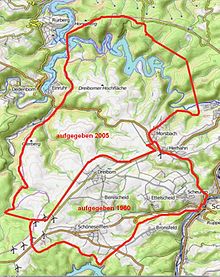Vogelsang Training Area


The Vogelsang Training Area (
Until 1950 the training area was run by the
History
Origins

The basis of the subsequent military training area was the Nazi

British use from 1946
After the end of the
It was a popular destination for British troops as an alternative to base barracks life. Under the Drawdown of British Forces from Germany, in the 1990s the camp was closed to British Army troops.
Belgian use from 1950

From 1950 the Belgian forces used the terrain as a military training area, establishing, extending and equipping the original Nazi fort to create the Van Dooren Barracks. In 1989 the site came under heritage conservation protection.
The Belgian military left Vogelsang Camp in late 2005.
Use since 2006

At the beginning of 2006, ownership of the land was transferred from the
Since 1 January 2006, the area and its solid stone buildings have been open to the public and may be visited during the day. Part of the land is crossed by hiking trails, but walkers must not leave the paths (mainly due to uncleared munitions and for nature conservation reasons).
Nature conservation
For decades large areas of Vogelsang Training Area were only used by the military, but were otherwise largely untouched, and have therefore become natural wilderness. Today they are elementary components of the Eifel National Park and its conservation concept. As a result of very low human intervention since the 1950s, especially the lack of agriculture and forestry, a valuable range of flora and fauna has developed. For example, the wildcat occurs in the woods on the training area and, around the outer edges, the strictly protected red-backed shrike.
In addition to the open land and woods of the Dreiborn Plateau, small stream valleys with tall, herbaceous vegetation, accompanying alder woods and underwater vegetation are of ecological interest. The slopes are covered in places by species-rich
Pollution is however still a problem, not only due to the use of the area after the war as a firing range and its more general use as a military camp, but also to a great extent due to spent
-
This forest path is open to the public
-
Young oak stand in the woods
-
Near-natural stream
Tourism
As well as the Nazi fort of Vogelsang, that is now the main attraction after being out of bounds to the general public for decades, the National Park and nature tourism also play a role in drawing visitors to the former training area terrain. One special place of interest is the abandoned village of Wollseifen, once a small hamlet on the Dreiborn Plateau that had to be evacuated when the training area was established in 1946.
Other places of interest are viewing points with wide views of the Urft Reservoir and valley, various military installations scattered over the out of bounds area and several ruined settlements like the former village of Vogelsang and other small hamlets. For example, at Jägersweiler there are several old farms and cottages (Kotten); the family of European champion aerobatic flyer, Liesel Bach, lived in one of the empty houses before it was cleared.
-
Wollseifen, the "ghost village"
-
Wollseifen church
-
Houses built by the Belgians in order to conduct urban warfare training
-
View of the fort from Wollseifen. Pollution in the foreground
Literature
- Hans-Dieter Arntz: Vogelsang - Geschichte der ehemaligen Ordensburg. Helios-Verlag, Aachen 2008, ISBN 978-3-938208-71-7

- Franz Albert Heinen: Vogelsang - Von der NS-Ordensburg zum Truppenübungsplatz in der Eifel. Eine kritische Dokumentation. Helios-Verlag. Aachen. 2002.
- Franz Albert Heinen: Vogelsang. Im Herzen des Nationalparks Eifel. 2nd ed., Gaasterland-Verlag. Düsseldorf 2006, ISBN 3-935873-11-5
- Traditionsverein Wollseifen (Hg.): Wollseifen - Das tote Dorf. Schleiden. (Selbstverlag) o.J.
External links and sources
- Overview at the National Park Association
- www.nationalpark-eifel.de (Leaflet on the Dreiborn Plateau, 2009)
- Natura 2000: Stream valleys in the Vogelsang Training Area
- The Bundeswehr on the NATO training area of Vogelsang/Eifel
- sdw-nrw.de - Background information on the NP Eifel and the Vogelsang Training Area
- verschiedene 360° panoramic view by Peter Braatz
- Wollseifen Society (on the history of Wollseifen)
- vogelsang-ip.de (Vogelsang Development Company)
References
- ^ 1:25,000 map series "Schleiden" Archived 2013-12-27 at the Wayback Machine published in 1894, Königl. Preuss. Landes-Aufnahme 1893. Retrieved 26 Dec 2013.
- ^ Kamp Vogelsang - Enkele cijfers Archived 2012-08-31 at the Wayback Machine at www2.kamp-vogelsang.be. Retrieved 26 Dec 2013.







